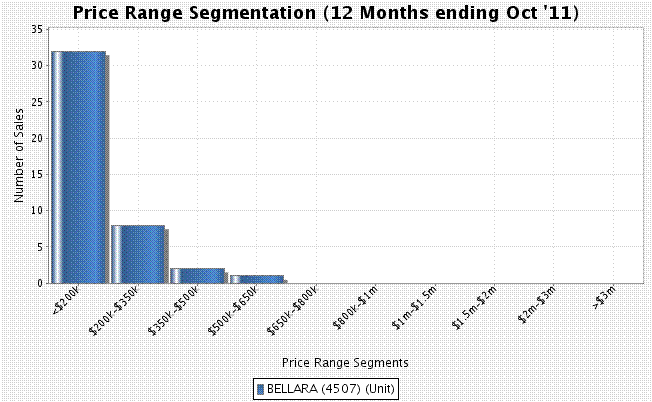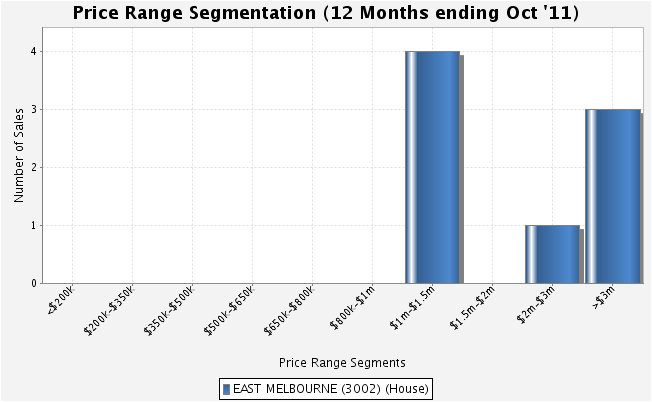League tables for suburb performance based on medians can make for popular reading. However the results should often be challenged, especially where sample sizes are small, property sales not representative or where the price ‘distribution curve’ is skewed.
For an agent working in one of these ‘worst’ suburbs, it is always good to know the ‘true’ growth figure, especially when questions or concerns are raised by vendors or purchasers. Sometimes the truth may be that one of your local suburbs is performing poorly, however if it is the result of some statistical anomaly, you certainly do not want to be troubled by it when already facing tough market conditions.
Let’s look at two recently published ‘worst’ suburbs:
Bellara 4507 QLD Units
The published figure states a ‘minus 65%’ growth rate. The suburb has around 10 sales per quarter currently, giving us a median of around $116,000. Back in Q2, 2010 we saw just 4 sales, which returned a median of $360k.
Neither the current samples of 10 or the prior sample of 4 are large enough to rely upon. If we changed our sample time period from 3 months to 6 months, we see an entirely different result. Using 6 months to October 2011 gives us a median of $115k and a sample size of 15. The same period 12 months earlier returns a median of $110k and a sample of 15 as well. The growth rate using this approach returns a plus 5% result. This result is very different from the minus 65%.
Whilst the sample size of 15 is much more reliable than the quarterly sample size, the reliability of the data should probably be questioned due to the ‘distribution’. Using a ‘price segmentation graph’ we would prefer to see something that looks a little bit like a bell-shaped curve in the current sample and also the prior year sample. Without both periods offering us an approximately normal distribution of values, we can’t rely on the plus 5% result.
East Melbourne Houses
The league table states this suburb has fallen in value by 43% in the last 12 months. When we look at the total number of sales in the last 6 months (to October 2011) we count just 2 sales! It is hardly a representative sample size. Even if we expand the sample period to 12 months till Oct’ 2011 we still only have 8 sales.
Using the full 12 month sample period returns an entirely different result. The median for the last 12 months was $1.88m. Compared to the year prior (median of $1.67m) we can arrive at a positive growth rate of nearly +13%.
As per our Bellara sample, the price distribution hardly resembles a bell shaped curve and indicates that the result may be unreliable.
Tips:
Whilst by no means an exhaustive list, here are a few tips for agents when reviewing median prices.
- As a general rule, try and work with sample sizes of around 20
- If comparing time periods, ensure you maintain apples with apples (e.g. 6 month sample periods)
- Look at the price segmentation graph – it ideally should a little like a bell-curve
- Watch out for new unit developments or new house and land releases. They will boost medians short-term and can often have the reverse effect long term.
- Expand your sample from suburb to postcode if required. If sales volumes still too low, you may have to expand to LGA.
Kent Lardner



6 Comments
Guy Robinson
Good article, but unless the suburb you are measuring consists of very similar real estate, like a subdivision where most of the houses are the same, then the sample size of 20 is far too low. Where a suburb has a wide range of product and pricing I personally would not rely on a sample of sales less than 200.
In the Newcastle market where our business trades the median statistical data for “Newcastle Strata” is often skewed by the release of large apartment projects, which often have prices far higher than the median of older walk-up unit sales. When these sales settle the median rises for that quarter, then of course crashes again the next quarter to the delight of local media.
In actual fact nothing at all may have happened, yet the “reports” show prices have apparently been rising by x% and then falling by y%, all within a period of 6 months. These reports are often associated with the local clown agents cheering the apparent non-existent price rise and denying the non existent price fall to the local press. No wonder agents credibility is so low!
Kent Lardner
Thanks for reply Guy. What a great part of the world you live in.
Point taken. Wording should have been ‘As a general guide for most normally distributed markets’ or something along those lines. I’m just glad that the message got across OK. Taking a look at Newcastle UNIT market price segmentation graph – it looks like an array of many markets and two very distinct price distribution curves. Very hard to rely on for medians.
Guy Robinson
I think the main thrust of your article is the key, and what you are saying is that medians are a measure, but not one that can be solely relied upon. The best agents with the largest volume of sales in any market will have a better idea of how any market is performing, and they should question median’s that can indicate to the public a market that is not reality, especially where there are small samples and a diversity of product in any measured market.
What would be a breath of fresh air in our industry would be some honesty. It is not a vendors agents job to defend house prices. House prices go up, down and sideways. It is our job to get the best price in the market, not to ensure prices never fall. The dopes out there that froth at the mouth whenever someone mentions “discounting” or “property prices falling” just make the industry look stupid and unprofessional. I for one cannot figure out why agents behave like this. Anyone see any stockbrokers out there denying share prices ever fall?
Leanne Pilkington
I couldnt agree more Kent. I have had this conversation many times. In a market when the top end is slow the median price might drop dramatically as a result of limited high end sales. Its not a true reflection and must be used carefully.
Ryan O'Grady
The beauty of stats and how you can manipulate the data to meet your needs.
Aaron Clausen
Totally agree, good article Kent.